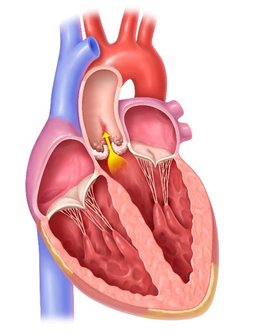AORTIC STENOSIS
AORTIC STENOSIS
AORTIC STENOSIS: A SERIOUS AND PROGRESSIVE VALVE DISEASE

The heart has four valves that direct blood flow between the chambers of the heart. These valves act like one-way doors, allowing blood to flow forward into the next chamber. The valves close to prevent backflow.
On the left side of the heart, blood flows through the left ventricle into the aorta — the main artery of the body — through the aortic valve. The aortic valve has three flaps of tissue, called leaflets, that open and close to ensure that blood flows in only one direction.
Aortic stenosis, or AS, occurs when the leaflets become thick or stiff, which causes a narrowing of the aortic valve. Because of this, the valve doesn’t open and close properly, which restricts the flow of blood out of the left ventricle into the aorta.1,2 This makes it harder for the heart to pump oxygen-rich blood to the body, which can affect overall health.
Aortic stenosis is a common
valve disease, affecting more than
12% of people aged 75 and older.3
What causes aortic stenosis?
Aortic stenosis most commonly occurs in people 65 and older as a result of scarring and calcium buildup on the valve leaflets. Aortic stenosis causes include scarring and calcium build up that may be from a normal sign of aging or from prior chest radiation. It may also result from having rheumatic fever during childhood, which is now rare in the United States.1,4
Aortic stenosis may be present in young people due to a birth defect, the most common being a bicuspid aortic valve. This is where only two leaflets grow instead of the normal three.1,4
What are the symptoms of aortic stenosis?
Aortic stenosis symptoms may not be noticeable during the mild-to-moderate stages of the disease when blood flow is not significantly reduced. As damage to the leaflets worsens, the valve further narrows and blood flow is greatly reduced.1
Once the disease progresses to this severe stage, aortic stenosis symptoms may include1:
- Shortness of breath
- Feeling dizzy or light-headed, even fainting
- Difficulty walking short distances
- Decline in activity level or reduced ability to do normal activities
- Chest pain
- Rapid, fluttering heartbeat
- Swollen ankles or feet
- Difficulty sleeping or needing to sleep sitting up
The symptoms of aortic stenosis can be misunderstood as “normal” signs of aging — if someone is experiencing any of these symptoms, see a doctor right away.
If someone is diagnosed with severe aortic stenosis and start to experience symptoms, it is important to get treatment right away. A doctor should be contacted if any of these symptoms happen or if symptoms are worsening.
Patients diagnosed with mild-to-moderate aortic stenosis who have no symptoms should receive regular clinical and echocardiography exams to monitor the progression of their valve disease.5 Echocardiography is a test that uses sound waves to produce live images of the heart that allows a doctor to monitor how the heart and its valves are functioning.
Aortic stenosis is progressive and life threatening
Aortic stenosis is a progressive disease, which means that it will become more severe over time. As leaflets become more damaged, the heart must work harder to pump blood through the narrowed valve opening. This causes the wall of the left ventricle to enlarge and thicken and the heart to weaken, reducing the amount of blood supplied to the body. In time, this may lead to heart failure and death.1,4
From the onset of symptoms, risk of death from severe aortic stenosis is as high as 25% at 1 year and 50% at 2 years in patients who do not undergo aortic valve replacement.6
How is aortic stenosis treated?
Aortic stenosis treatment depends on the severity of the condition; whether someone is experiencing symptoms, and if the condition is getting worse.5
Early treatment is key to prevent progression to heart failure.2,4,5
Patients with mild-to-moderate aortic stenosis may be prescribed medications to help manage their symptoms or reduce the burden on their heart.5 However, currently available medications cannot cure aortic stenosis.4
In some cases, the valve is temporarily opened through a procedure called balloon valvuloplasty.5 In this procedure, a small balloon catheter is threaded into the heart through an artery and then inflated to open the valve. However, the valve will eventually narrow again, requiring additional procedures.
Aortic valve replacement
Once aortic stenosis progresses to the severe stage, the only aortic stenosis treatment option is to replace the diseased aortic valve. In some cases, a doctor may recommend aortic valve replacement even if someone is not experiencing symptoms.5
There are two options for replacing your aortic valve:
- Surgical aortic valve replacement (SAVR): SAVR is an open-heart procedure, where a surgeon removes the damaged valve and replaces it with a mechanical valve or a bioprosthetic (tissue) valve.2
- Transcatheter aortic valve replacement (TAVR or TAVI): TAVR/TAVI is a less invasive procedure that uses a catheter threaded through an artery to implant a new valve within the diseased aortic valve.2
Most patients can resume a healthy, active life after valve replacement.
The choice of proceeding with SAVR versus TAVI is based on multiple factors, including risk score, frailty, comorbid conditions and personal preferences and values.7
To determine what type of valve is best, a doctor will take many factors into consideration, such as age, overall health and medication requirements.7
The information provided is not intended for medical diagnosis or treatment as a substitute for professional advice. Consult with a physician or qualified healthcare provider for appropriate medical advices.
MAT-2201404 v2.0 | Item approved for OUS use only.